How to cook the perfect cassoulet
Is a dish of ham hock, duck legs, pork belly and sausages the perfect meat feast – or just plain greedy? And does any other recipe make a better use of beans?
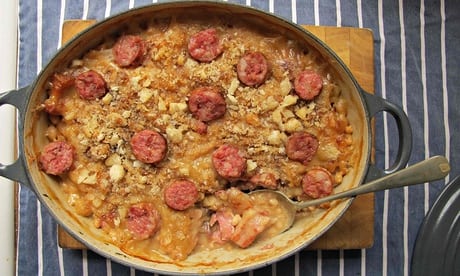
Felicity Cloake's perfect cassoulet. Photographs: Felicity Cloake for the Guardian
Cassoulet, that deceptively humble Gascon mess of meat and beans, is a desert-island dish for me – if that island happened to be of the bleak and chilly variety. Like many dishes that come under the modish heading of "peasant" fare, it is hearty stuff, designed to fuel hours of hard physical toil.
And, also in common with many other "peasant" dishes, the proper way to make cassoulet is hotly debated – as Paula Wolfert writes in The Cooking of South-west France, it's one of those dishes "over which there is endless drama". Every town in the region is said to have its own speciality – indeed, food writer Richard Olney reckons "there are as many as there are cooks". Fortunately, there is nothing I like more than a culinary bunfight.
Beans
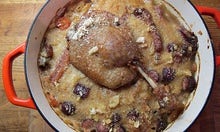
Caroline Conran's cassoulet.
Beans are the backbone of the dish. It is likely that beans would originally have made up the lion's share of it, and they should still make up the bulk – this isn't a mixed grill. Indeed, beans can make or break a recipe, as Jeanne Strang explains in Goose Fat and Garlic: "The essence of a good cassoulet is that the beans, while not falling apart, should be tender and should have absorbed the aromas and savours of the other ingredients."
White beans are generally called for, with some authors specifying haricot – but haricot is a large and sprawling family, and the varieties generally preferred in its homeland are hard, if not impossible, to come by here. Elisabeth Luard, the author of European Peasant Cookery, points me towards haricots de soissons for optimum soft creaminess, but these big white beans prove elusive, so I have to make do with ordinary dried haricot, and the cannellini suggested as a substitute by Caroline Conran in her award-winning book, Sud de France. The larger cannellini are probably the closest I'm going to get to the traditional bean (butter beans are widely condemned as totally unsuitable), but I'm not convinced: the smaller haricot yield a creamier result. (They're also noticeable cheaper, which seems truer to the spirit of the dish.)
Overnight soaking is advisable, especially if you're not sure how old your particular beans are, but is not, I am surprised to discover, an absolute necessity. Elizabeth David gives a recipe she credits to one Auguste Columbié, a Languedoc native and proprietor of a Paris cookery school "for young ladies", which brings the dried beans to the boil, leaves them to soak for 40 minutes, then drains and proceeds with cooking as usual. The beans turn out perfectly tender, so if you haven't prepared them in advance, all is not lost.
Some recipes, including Wolfert's, bring the beans to the boil and then drain them before cooking, but skimming the scum from the top works well and saves energy to boot.
Meat
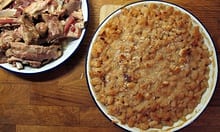
Auguste Colombié's cassoulet.
It takes me several days to track down the smörgåsbord of meats required for my cassoulets; from confit goose to shoulder of mutton and huge hunks of pig skin (or rind, as it's more delicately known), it is not a dish for the faint-hearted. Looking at my shopping list, it is clear that the meat content is divided into three main categories.
First off, there's the stuff used to season the beans – usually a combination of salted meats, such as hunks of pancetta, bacon or cured pork belly, and fat and gelatine represented by pork rind and trotter, as used by Olney, Hugh Fearnley-Whittingstall, Wolfert and Luard. I find the salted meats are disappointingly dry after being simmered with the beans for hours on end, while the rind, even when used to line the base of the dish, as many recommend, is not the most pleasant thing to come across in a mouthful, managing as it does to be simultaneously blobby and chewy.
After my sourcing adventures, I am also mindful that neither a hunk of cured meat nor pork skin are likely to be easy to obtain for most people in this country. I recall Wolfert's mention of ham in the traditional Castelnaudary cassoulet, and her use of fresh ham hock in her Toulouse-style version, salted overnight. Once slow-cooked with the beans, that hock yielded nuggets of tender, delicious meat, while the skin had done the work of the rind and trotter. Combining the two in a cured ham seemed the obvious answer. A word of caution, though; check the packaging or ask your butcher whether it should be soaked before use – a particularly salty ham runs the risk of ruining all your hard work.
The second category of meat is what I come to think of as the bulk – pork (Wolfert, Luard), mutton shoulder (Olney), pork ribs (Conran and David), pork belly (Fearnley-Whittingstall) or lamb breast (David). I'm not keen on those recipes using lamb or mutton; the latter in particular has a strong flavour that dominates everything. Shoulder of pork is fine, but a bit dull in comparison with the melting tenderness of the belly and ribs – I prefer the former, as the meat has a tendency to slide off the rib bones after such long, slow cooking, leaving the dish studded with empty ribs.
Olney and Wolfert make a ragout of this bulking meat, but, delicious as it is, this seems an unnecessary faff given the later slow cooking involved – browning it well for flavour, as Fearnley-Whittingstall, Luard and David suggest, is sufficient (David roasts it, but it is far easier to do this in a hot pan, especially given all the duck fat you'll have knocking about).
The final helping of meat contains the real stars of the show: confit and sausage. The first is easily dealt with: most recipes specify duck, although Olney insists on goose (generously allowing that if you can't get hold of one to confit yourself, goslings will do at a pinch). Frankly, with everything else going on in the dish, I can't tell the difference, except for the price. Pre-cooking the legs slightly, to brown the fat and soften the flesh, is a wise idea – it also makes it easier to take the meat off the bone, which in turn makes it easier to divide up for serving.
Sausage-wise, most recipes call for Toulouse, though Wolfert strikes out on a brave limb with the famously pungent andouillette, but my testers are less than impressed by its manure-like flavour. Conran suggests Polish kielbasa as a Toulouse substitute, but the smoky sort I use makes everything taste like a frankfurter, so I'd steer clear – basically, you need something with a very high meat content, and preferably a hefty whack of garlic.
Studding a few slices of sausage on top of the dish so they crisp up with the breadcrumbs, as in Fearnley-Whittingstall's recipe, lends some extra textural interest to proceedings.
Seasoning and flavouring
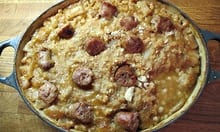
Hugh Fearnley-Whittingstall's cassoulet.
Thyme, bay and parsley are popular herbs for cassoulet – I can't really detect the parsley, but if the first two are good enough for the famously exacting Olney, then they're good enough for me. Conran and Strang stud their onion with cloves, but I'm not keen on the flavour in combination with garlic, and the latter is non-negotiable; cassoulet ought to be almost offensively garlicky to balance out the richness of all that fat. Wolfert makes the inspired suggestion of slow-simmering a whole head until sweet and tender, then mixing it with pork fat and a few fresh cloves, and stirring it through the cooked beans. I use Italian lardo, or cured pork fat, for her recipe, but it strikes me that it would be far easier, and still in keeping with the spirit of the dish, to substitute duck fat, which is readily available in supermarkets these days.
Vegetables
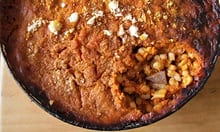
Richard Olney's cassoulet.
Cassoulet isn't a dish that demands much in the way of vegetable matter, though a green salad is its dream date – the carrots in most recipes end up too mushy for my liking, and Olney's tomatoey sauce seems to belong to a different dish. The merest smidgen of tomato is more common, and in this country, and at this time of year, Wolfert's sun-dried tomato paste seems the safest of way of delivering it (and, let's be honest, cassoulet and tomato season are unlikely to ever coincide).
Topping
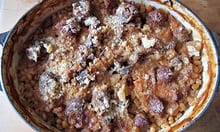
Paula Wolfert's cassoulet.
Not everyone tops their cassoulet with breadcrumbs. Wolfert explains that this is sometimes seen as a lazy way of achieving the crust that a well-made cassoulet ought to develop on its own in the oven, but goes on to say that "the woman who cooked the best traditional cassoulet I ate used breadcrumbs without a qualm". I'm going to follow her example – they add a lovely crunchy element to the dish. Stirring them back into the beans a couple of times, as Fearnley-Whittingstall suggests, only thickens this crust. (Tradition dictates it ought to be stirred in seven times before the cassoulet is ready, but tradition probably had nothing better to do than sit by the oven for two hours with a wooden spoon.)
A final piece of brilliance from Wolfert: sprinkling the dish with walnut oil just before serving "brightens" the taste of the beans – and, at this point, a bit more fat really can't hurt.
The perfect cassoulet
(Serves 6-8)Drain the beans well and put them in a large, ovenproof casserole dish. Pour in water until it comes about 3cm above the top of the beans, then add the onion, whole head of garlic, herbs and ham hock. Bring to the boil, then cover and simmer for about two hours, until just tender, but not falling apart.
Meanwhile, fry the duck, pork belly or lamb breast, and sausages separately in plenty of duck fat until crisp and golden. When cool, cut the sausages into large chunks and strip the meat from the duck in large pieces.
Remove the onion and herbs from the beans and discard. Remove the ham hock and, when cool enough, strip the meat from it. Squeeze the garlic cloves from their skins and mash to a paste with four tablespoons of duck fat and the fresh garlic cloves. Stir in the sun-dried tomato paste. Preheat the oven to 140C/275F/gas mark one.
Drain the beans, reserving the liquid. Grease the bottom of the casserole with a little of the duck fat mix, then tip in the beans, the rest of the duck fat and the pieces of meat, keeping back half the sausage. Mix well, then top with just enough liquid to cover – you probably won't need to add any seasoning, as both the ham and the confit will be quite salty.
Fry the breadcrumbs very briefly in one tablespoon of duck fat, then top the cassoulet with a thin layer of them. Bake for about two hours, keeping an eye on it – once a crust has formed, stir this back into the cassoulet, and top with some more of the breadcrumbs. By the end of the cooking time, you should have a thick, golden crust.
Drizzle with a little walnut oil, and leave to cool slightly before serving with a sharply dressed green salad.
Cassoulet: are you a fan of the Toulouse, the Castelnaudary or the Carcassonne variety – or do you prefer a Brazilian feijoada or a hearty pot of Boston baked beans? What do you serve with your cassoulet, if anything, and will anyone speak up for the unfortunate andouillette?